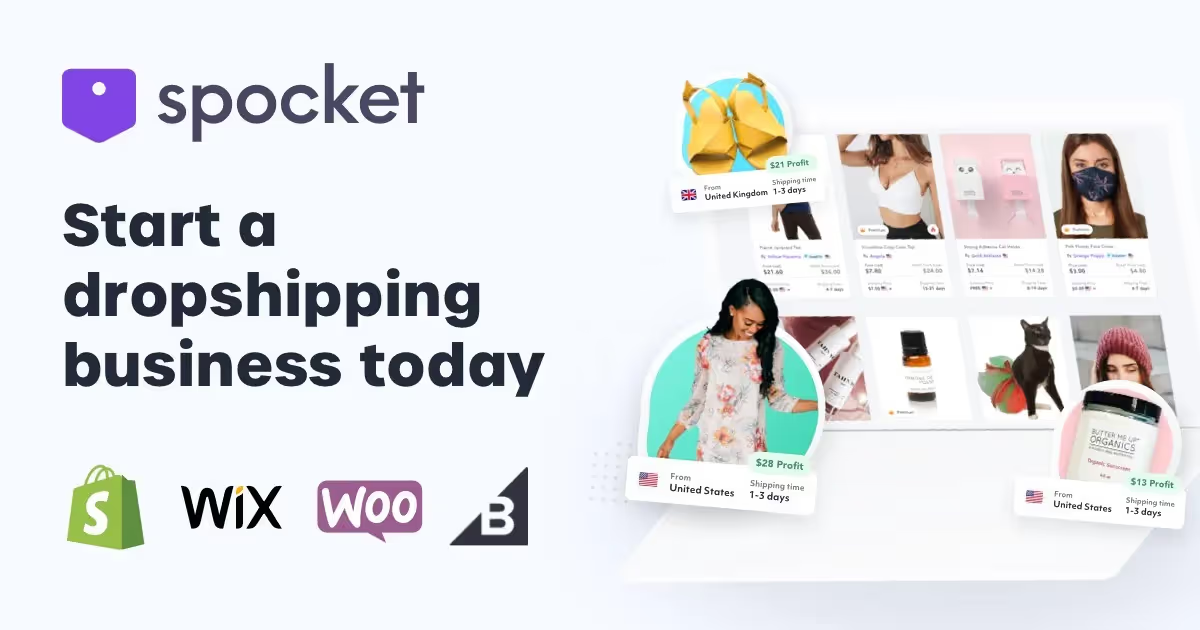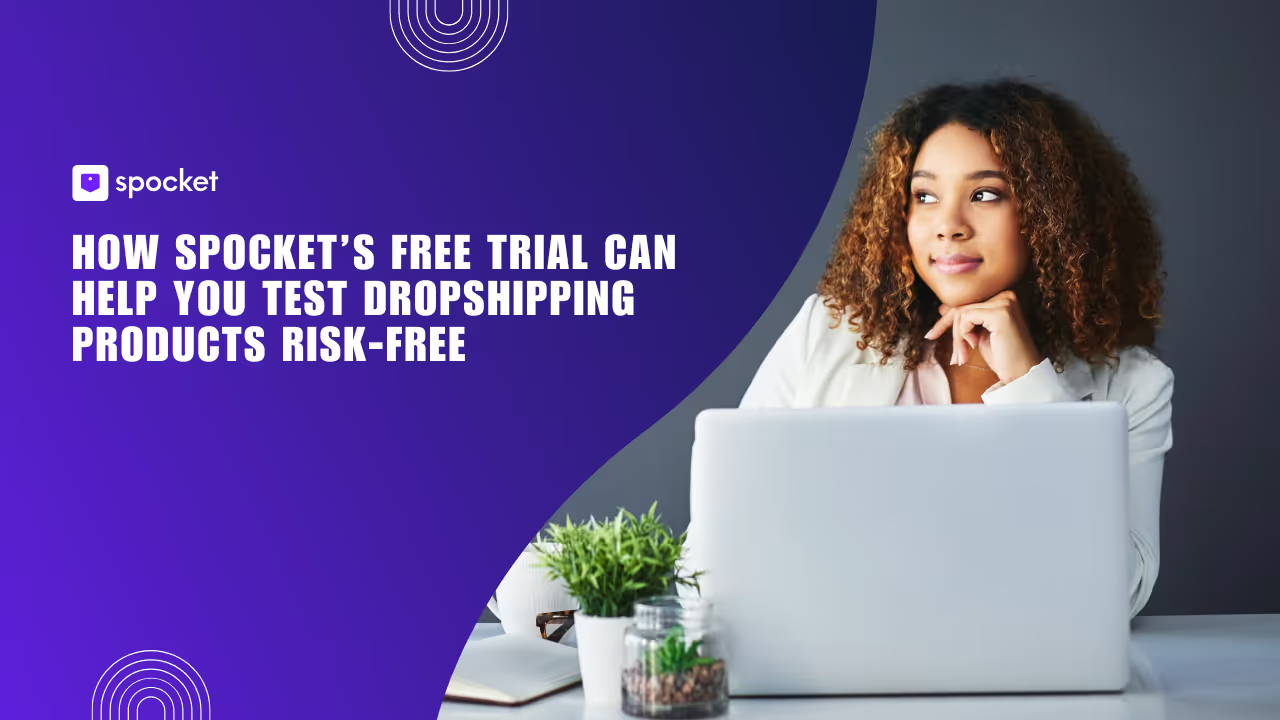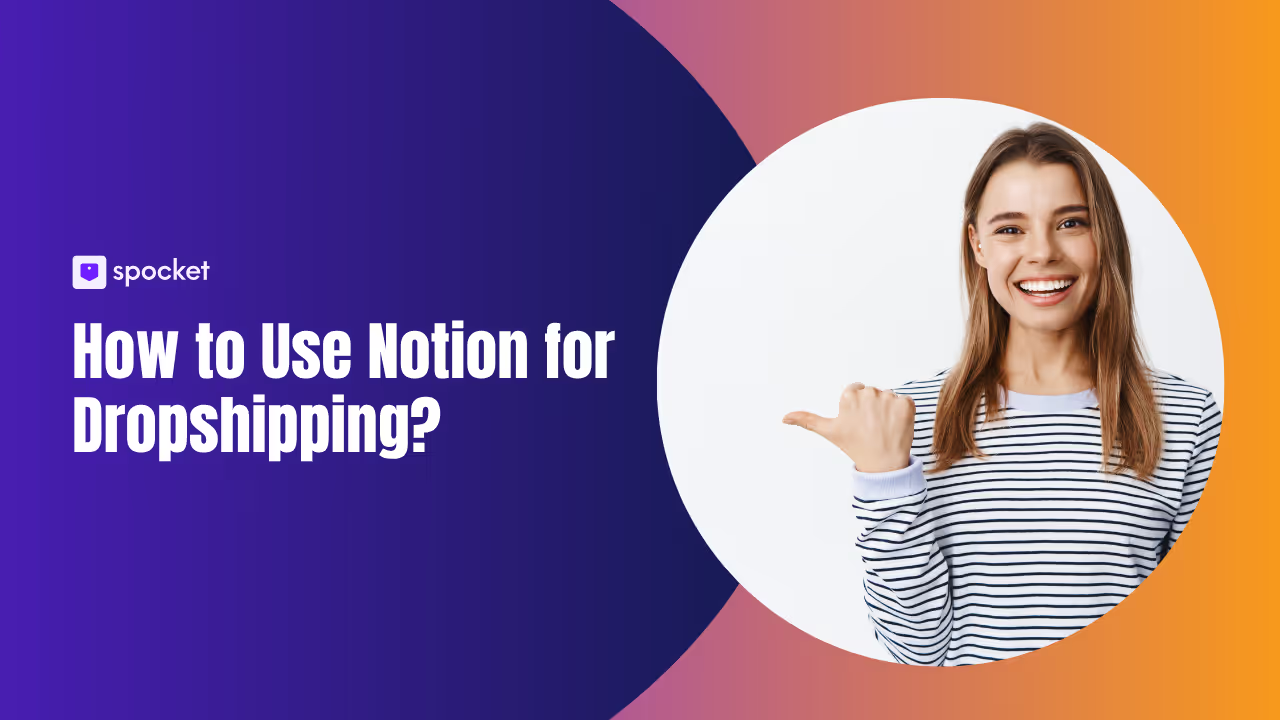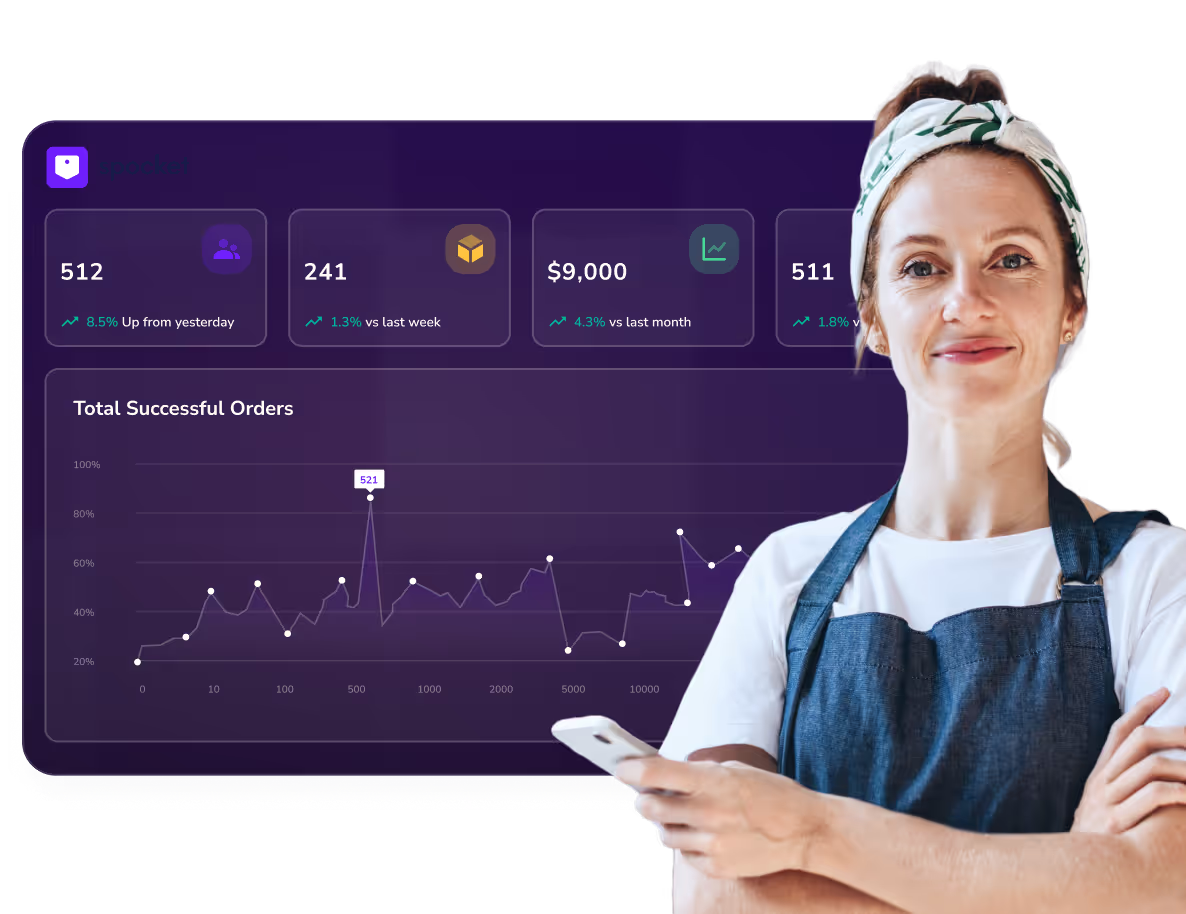Every dropshipper dreams of discovering that one product that sells effortlessly, without spending weeks or wasting money on guesswork. That’s where the Spocket free trial becomes your best testing ground. It’s a 14-day opportunity to test dropshipping products, explore real suppliers, and experiment without upfront risk.
Think of it as your business sandbox. You can browse trending items, import a few promising ones to your store, and even run small campaigns to see what clicks with your audience—all before committing to a plan.
The challenge? Most people rush through the trial, explore a few listings, and leave without any insights. This guide is here to change that. You’ll learn how to turn those 14 days into a focused, data-driven testing sprint that helps you identify winning products before you spend a single dollar.
What The Spocket Free Trial Really Covers — Features, Limits & Hidden Rules

Before jumping into product tests and marketing experiments, you need to understand what the Spocket free trial actually gives you access to. This is more than a peek behind the curtain—it’s a complete hands-on experience that, if used wisely, can reveal your next winning product. Let’s unpack what’s inside, what’s not, and how to use it to your advantage.
What’s Unlocked During Your 14-Day Trial
The 14-day trial gives you near-full access to Spocket’s ecosystem. You can browse verified suppliers, import products directly to your store, and even place sample orders to test product quality, packaging, and delivery times. It’s a real operating environment, not a sandbox. You can also explore premium features like branded invoicing and supplier chat, which make your store feel more established. But remember—each trial plan mirrors its paid tier, so your product import limits depend on which version you choose. Pick a tier that fits your testing ambitions before you start experimenting.
Cancellation Policy, Refund Rules, And How To Avoid Surprises
Here’s where most new users trip up: the trial requires you to enter billing details. If you don’t cancel before day 14, the plan renews automatically, and refunds aren’t guaranteed. It’s not a trap—it’s just how the billing cycle works. To stay safe, mark day 12 on your calendar. By then, you’ll know whether you’ve found a product worth keeping. If not, head to your account settings and cancel with a couple of clicks. This way, you leave with data, not regret.
Why The Trial Is Low Risk But Not Zero Risk
The Spocket trial dramatically reduces financial risk, but it still mirrors the realities of dropshipping. You’ll face real shipping delays, varying supplier communication, and product quality differences. That’s precisely what makes this period valuable. Treat it as a stress test for your future business. How do suppliers respond when you ask questions? Are the delivery estimates accurate? Does the packaging meet your brand standards? Every insight you gain now helps you avoid costly mistakes when your store goes live.
How To Run 5 (Or Fewer) Mini Experiments During Your Spocket Trial
Now that you understand what the Spocket free trial includes, it’s time to make those 14 days truly count. The goal isn’t to test everything—it’s to run intentional, focused experiments that give you clear answers. With just a few well-designed tests, you can uncover what really sells and what doesn’t before your trial ends.
Why Fewer Tests Lead To Clearer Results
Many beginners waste their trial by testing too many products at once. That might sound efficient, but it actually clouds your results. Narrowing your focus to a few promising items helps you gather meaningful data on what works—conversion rates, fulfillment times, supplier communication, and customer feedback. Think of this phase as your business laboratory. The fewer variables you have, the easier it is to identify your winners.
Experiment 1: Test Fast-Shipping Products From US/EU Suppliers
Fast delivery can be a make-or-break factor in dropshipping success. Use the trial to select a few products from US or EU suppliers and compare how shipping speed affects conversion. Run small ads emphasizing quick delivery and track your results. You’ll often find that highlighting faster shipping increases customer trust and boosts sales.
Experiment 2: Compare Branded Versus Generic Product Pages
Brand perception changes everything. Take one product and create two versions of its page—one with a branded feel (custom description, logo, high-quality photos) and another that’s completely basic. Split your traffic evenly and monitor conversions. This test will reveal whether a polished, consistent brand identity gives you an edge over plain listings.
Experiment 3: Test a Funnel Landing Page Versus Direct Product Page
Not all customers buy right away. Try sending half of your traffic to a simple landing page or quiz that introduces your offer, and the other half straight to your product page. Compare engagement, time on page, and checkout rates. This test helps you understand if your audience needs a little warming up before making a purchase.
Experiment 4: Bundle And Variant Testing
Bundles can raise your average order value without additional ad spend. Choose complementary items—like a watch and strap or skincare duo—and create a bundle at a slightly discounted rate. Track how many customers choose the bundle over individual products. If it performs better, you’ve found an easy way to increase profit margins.
Experiment 5: Retargeting Campaign For Mid-Trial Optimization
Around day seven, review your traffic data. Identify people who viewed your products but didn’t check out, and run a small retargeting campaign. Use new creatives, such as customer testimonials or lifestyle images. This quick test shows whether your offer needs stronger messaging or if buyers just need a little reminder to complete their purchase.
Each of these five experiments fits comfortably within Spocket’s 14-day trial. More importantly, they’re structured to generate actionable insights. When your trial ends, you won’t just have ideas—you’ll have hard data that tells you exactly which products and strategies are worth pursuing.
14-Day Testing Calendar & Allocation Plan (With KPI Benchmarks)
Running structured experiments is one thing, but timing them properly makes all the difference. With only 14 days in your Spocket free trial, every day matters. This calendar helps you plan what to do and when—so by the end of your trial, you’ll have solid results and clear decisions instead of confusion.
Day 1–2: Setup And Market Mapping
Start by defining your niche and identifying what your target audience actually wants. Research trending categories on Spocket and shortlist products that align with your audience’s interests. During these first two days, set clear success criteria—like your target conversion rate or average order value—so you know what you’re measuring against.
Day 3–4: Product Selection And Sample Orders
Choose five products or fewer based on supplier ratings, delivery times, and reviews. Order samples right away to test product quality and packaging. Use this time to finalize your store layout, upload product photos, and write compelling descriptions. The goal is to have a test-ready store by the end of day four.
Day 5–7: Launch Campaigns And Early Optimization
Now it’s time to run ads or social campaigns. Use small daily budgets and test multiple creatives for each product. Track metrics like click-through rate (CTR), add-to-cart (ATC) rate, and cost per click (CPC). By day seven, you should start spotting early patterns—some products will gain traction, while others may underperform.
Day 8–10: Double Down On Winners
At this stage, you’ll have enough data to identify your top-performing products. Pause campaigns for products that didn’t meet your goals and shift the budget toward the ones that did. Experiment with retargeting ads and product bundles to improve your average order value. Keep fine-tuning your product pages for better conversions.
Day 11–12: Analyze Supplier Performance
Reach out to your suppliers about shipping times, restocking, and branding options. See how quickly they respond and how transparent they are about fulfillment details. This gives you insight into long-term reliability. You can also start measuring delivery consistency from your sample orders by now.
Day 13–14: Evaluate And Decide
It’s time to assess everything. Look at your KPIs, calculate margins, and evaluate which products meet your success benchmarks. Create a scorecard comparing CTR, ATC, conversion rate, fulfillment speed, and communication quality. Based on these insights, decide whether to continue with a paid plan or end the trial and refine your approach.
KPI Benchmarks To Measure Performance
To keep your analysis simple, track these key metrics throughout your 14 days:
- Click-through rate (CTR): Aim for 1.5% or higher.
- Add-to-cart (ATC) rate: Try for at least 4%.
- Conversion rate: A good benchmark is 2–3%.
- Cost per acquisition (CPA): Keep this below 25% of your product’s profit margin.
- Fulfillment time: Ideally under five business days for US/EU suppliers.
This schedule ensures that by the time your trial ends, you’ll have clear data—not guesses—guiding your next move. Instead of wasting time or missing opportunities, you’ll know exactly which products and suppliers deserve your commitment.
How To Leverage Spocket’s Core Features To Mitigate Risk And Optimize Tests
.avif)
Knowing what to test is only half the battle—how you use Spocket’s features determines how accurate and risk-free your results will be. These tools are designed to simplify testing, minimize mistakes, and give you clearer insights during your free trial. Let’s look at how to make each one work for you.
Smart Supplier Filters You Must Use
Spocket’s supplier filters are one of its biggest advantages for product testing. Instead of guessing which supplier is reliable, you can filter by location, shipping time, rating, and even branding options. Start by prioritizing US and EU suppliers if your target audience is in those regions—fast delivery builds trust quickly. You should also look for suppliers with verified badges and high fulfillment rates. These filters save time and ensure that you’re testing products from partners who can handle real demand.
Automated Order Flow And Integration Advantages
Spocket integrates seamlessly with Shopify, WooCommerce, and Wix, making order automation effortless. Once an order is placed in your store, it’s automatically forwarded to the supplier for fulfillment—no manual tracking or double-checking needed. During your free trial, this helps you focus on what really matters: analyzing performance data. Automation also ensures consistency, which means your test results are more reliable and free from human errors.
Sample And Review Sourcing Through The Dashboard
One of the smartest moves you can make during your trial is to order product samples directly through the Spocket dashboard. This not only lets you assess product quality but also gives you authentic content for marketing. Use those samples for photography, video ads, or influencer collaborations. You can even collect early feedback from friends or testers to identify improvements. Gathering these reviews early strengthens your credibility before you fully launch.
Price Rules And Markup Presets In Spocket
Spocket’s pricing automation is a small feature that makes a big difference. Instead of manually calculating your profit margins for each product, you can set global pricing rules. For example, you can apply a fixed markup or a percentage-based increase across your catalog. This saves hours of manual work and ensures that every test runs with consistent margins. During your trial, play around with different price rules to see how price sensitivity affects conversions—it’s valuable insight before scaling your store.
Using these tools strategically transforms your 14-day trial from a casual test into a structured learning phase. You’ll collect accurate data, minimize mistakes, and make informed decisions with confidence.
Conclusion
The Spocket free trial isn’t just a promotional offer—it’s a window to build proof, gather data, and discover what truly sells before spending a single dollar. If you use those 14 days strategically, you’ll walk away not only knowing which products work but also how your future business should operate.
You now have a roadmap: run a few focused experiments, track meaningful metrics, and use Spocket’s tools to automate the messy parts. Whether it’s testing fast-shipping suppliers, comparing branded listings, or building a simple funnel, each step brings you closer to your winning product.
The truth is, most people waste their trial browsing without direction. You don’t have to be one of them. Use this guide to turn your free trial into a learning sprint—a test lab where you make smart mistakes, gather insights, and find products worth scaling.
When the trial ends, you’ll have more than results—you’ll have clarity, strategy, and the confidence to move forward without risk.






































